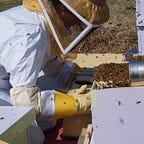Are Bees Dangerous?
Bees, especially honeybees, are an important part of the planet’s ecosystem. While doing rounds for food and pollen, these insects do us a favor by facilitating the pollination of plants. That’s how we get the foods and fruits that we eat and love so much. That said, unless you’re a beekeeper, you probably don’t fancy having bees for neighbors. In fact, in some states in the US, these insects have become infamously known as “killer bees.” But are they really that dangerous? Is a bee an insect you need to be deathly afraid of? Well, let’s find out:
1) Leave me alone, and I’ll leave you alone
A worker bee generally has no desire to sting anyone (Worker bees are often seen foraging plants for nectar). If you stay out of its way, it’ll stay out of yours. However, if you interfere with its business, it may retaliate with its pointy end, and once that happens, it’s like you’ve become a bullseye for nearby bees too. The stringer releases pheromones and venom continually for as long it remains in the skin, and this alerts other bees of the danger, like an enemy aircraft on radar. Once you get stung, the stings keep on coming, so it’s best to leave a roaming bee be.
2) Swarming bees can be more aggressive than usual
When a hive becomes too crowded for comfort, the population splits into two, with one half looking for a new place to live. This process is called swarming, and it’s an essential part of bee reproduction. The old queen leaves the nest in a cloud of worker bees, and they scout potential sites for growing a new colony. Resting swarms can stay in a particular area for about 48 hours before they up and leave. If they nest away from buildings and homes, then they shouldn’t be of too much concern. The problem arises though if bees set up camp in high traffic areas.
Bees in a swarm are usually on high alert and take even the slightest intrusion as a threat to their new colony and queen. Africanized bees, in particular, are more dangerous when swarming and can be a fatal threat to pets and humans. If you have a swarm in your backyard, it’s best to steer clear and call in a bee removal expert. The hive may have identified the inside of your walls as its perfect new home.
3) Bees can cause allergic reactions
A bee sting can be a life-threatening situation for people with allergies. The body overreacts to the venom and can lead to a heart attack, among other complications. It’s usually the case that people can develop these allergies later on in life even if they didn’t have them early on. Be sure to stop by the doctor’s every so often to ascertain your immunity. If diagnosed with allergies, it’ll be vital to have an epinephrine auto-injector on you just in case. Even for people without allergies, bee stings can still be pretty unpleasant.
4) Pets are more at risk
A buzzing insect minding its business screams play thingy to cats and dogs. Pets and bees are as good a match as oil and water, and it’s a recipe for disaster. If you spot a bee colony out in your yard, it’s best to lock up your furry companions until a professional gets a handle on the situation. Just like people, pets can develop severe allergic reactions.
In a nutshell, are bees dangerous to people?
Typically, no. Unless disturbed or aggrieved in some manner, bees rarely go out of their way to stir up trouble with an animal much larger than itself. Honeybees are social and docile creatures and won’t start a fight unless someone backs them into a corner.
Bees are not usually dangerous (although they can be when push comes to shove), but they are endangered. According to studies, the insect population has taken a nosedive in recent years, with honey bees among those most affected. Consequently, always opt for the safe and humane removal of bees if you have such a problem on your hands. It’s not overselling it to say that the future of an entire planet rests on the tiny shoulders of these little insects that do a lot for food production.
